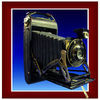Capturing cloud iridescence.
Mar 30, 2013 16:34:57 #
I took the following picture with a compact, and the cloud iridescence (the orange colouration on the right) wasn't captured very well. It was proper iridescence with the full rainbow spectrum, but the camera didn't capture the yellow, green or blue tint that was there to see.
I used SEARCH to see what other posters had, and one had the same problem, but two others (bulldog and zerbphlatz) had the full spectrum in their iridescence.
Now that I have a more capable camera, is there anything that I can do to help the camera capture the full spectrum of iridescence?
(Of course, the first problem that I'll have is that it's a rare phenomenon - which is why I want to be well-prepared for it).
I used SEARCH to see what other posters had, and one had the same problem, but two others (bulldog and zerbphlatz) had the full spectrum in their iridescence.
Now that I have a more capable camera, is there anything that I can do to help the camera capture the full spectrum of iridescence?
(Of course, the first problem that I'll have is that it's a rare phenomenon - which is why I want to be well-prepared for it).
Iridescence.
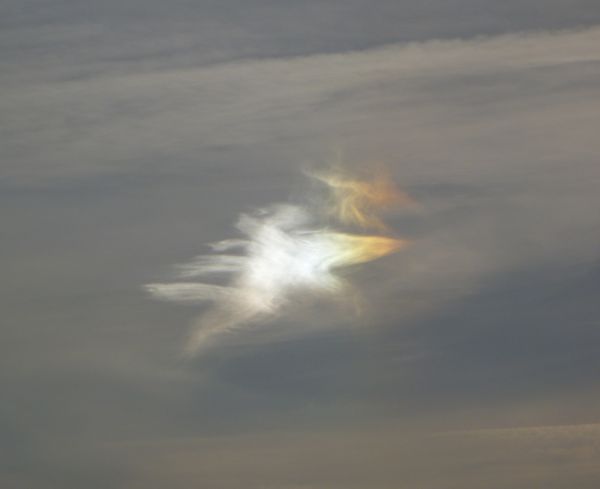
Mar 30, 2013 18:03:37 #
Your exposure settings are key. YOU decide via manual settings. Your camera will always try to even exposure, corner to corner, or spot metering, which tends to over-expose light areas. Do not rely on any auto settings.
Mar 30, 2013 18:09:01 #
Nikonian72 wrote:
Your exposure settings are key. YOU decide via manual settings. Your camera will always try to even exposure, corner to corner, or spot metering, which tends to over-expose light areas. Do not rely on any auto settings.
So do you think the iridescence was overexposed? The cloud itself comes close to whiteout, but I would have gone with that if it meant capturing the rainbow effect in the cloud.
EDIT:- My compact has an old-style CCD sensor, and I'm beginning to think that iridescence is just too subtle for it. My latest camera has a CMOS sensor, which may be sensitive enough to pick up the subtle tints.
Mar 31, 2013 07:25:03 #
I quickly threw your photo into Photoshop just to see what the results would be. Not having been there, I had to guess at the colors, but by darkening the whites, boosting the yellows and reds, it makes for a very nice abstract cloud photo. Most of the work was done in Bridge. I'll post, with permission, or you can try it yourself.
Mar 31, 2013 07:57:58 #
Al FR-153 wrote:
I quickly threw your photo into Photoshop just to see what the results would be. Not having been there, I had to guess at the colors, but by darkening the whites, boosting the yellows and reds, it makes for a very nice abstract cloud photo. Most of the work was done in Bridge. I'll post, with permission, or you can try it yourself.
Feel free, Al FR-153 (please post). I was beginning to think that PP was my only option with this photo. And I've already seen that clouds and rainbows make good PP subjects.
Mar 31, 2013 08:10:12 #
Again, this was a quick and dirty Photoshop attempt. Please take with a grain-of-salt if not to your liking.
Sun Dog Clouds
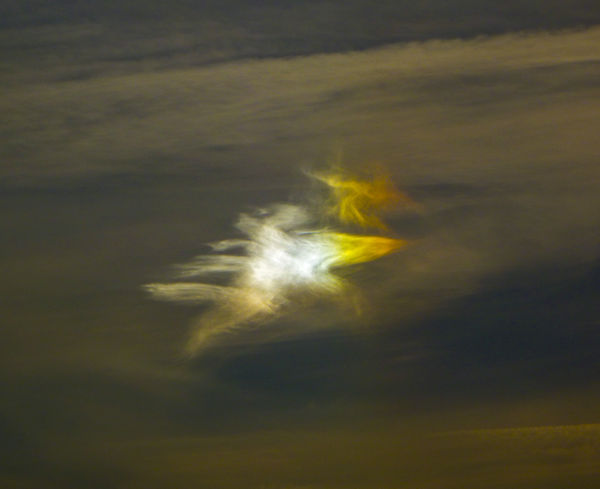
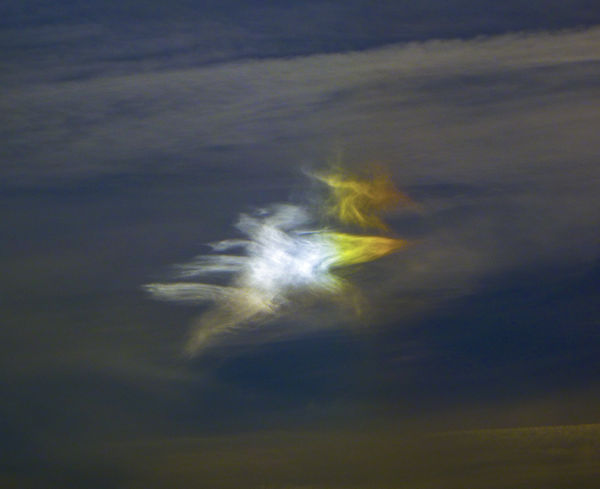
Mar 31, 2013 08:19:10 #
Yes, the effect is quire startling. It's a step away from what the cloud was like in reality, but since when was PP about reality?
You've inspired me to have a go myself. I'll try to get it back to what I saw, and I suspect that it'll need a touch of blue (or blue/green), since that seems to be what's missing from the iridescence.
Nice try, though. With your permission, I'd like to keep them.
You've inspired me to have a go myself. I'll try to get it back to what I saw, and I suspect that it'll need a touch of blue (or blue/green), since that seems to be what's missing from the iridescence.
Nice try, though. With your permission, I'd like to keep them.
A few light touches (this isn't as easy as it looks!)
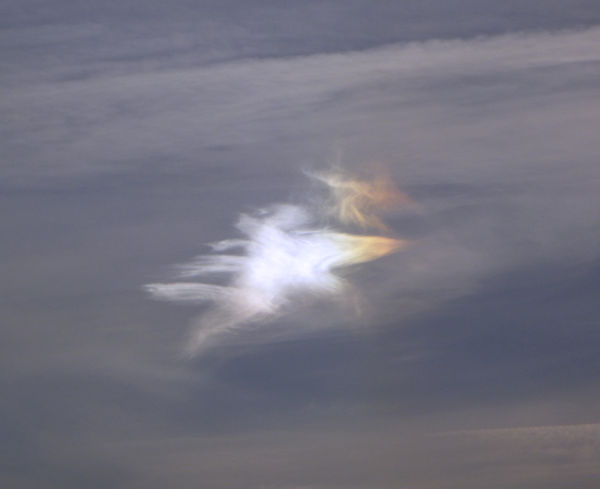
Mar 31, 2013 09:02:13 #
If the link that I'm trying to post goes through, it shows one of the best examples of iridescence that I've seen.
http://www.uglyhedgehog.com/t-34913-1.html
http://www.uglyhedgehog.com/t-34913-1.html
Mar 31, 2013 12:16:01 #
This might be a silly question but did you have a UV filter on for the shot. Rainbows will not work with a UV filter on.
Mar 31, 2013 12:21:52 #
They are yours. Thanks for allowing me to play with them. I see what you mean via the example. It looks more like a rainbow than a sun dog. Have fun playing with it.
Mar 31, 2013 15:16:08 #
GregShea wrote:
This might be a silly question but did you have a UV filter on for the shot. Rainbows will not work with a UV filter on.
No Greg, just a straight shot. The trouble is that the iridescence was far fainter than a rainbow would have been.
If I had to guess, I would say that the ISO would have to be as low as possible (the most important factor) and giving it as long an exposure as possible.
I suspect that another requirement is a camera that costs more than £180. Having said that, I think that what I said about CMOS sensors is probably true, and they are starting to find their way into cheaper P&Ses.
Thanks for looking and commenting.
Mar 31, 2013 15:19:30 #
Al FR-153 wrote:
They are yours. Thanks for allowing me to play with them. I see what you mean via the example. It looks more like a rainbow than a sun dog. Have fun playing with it.
Thanks, Al FR-153, and you're welcome. I think I've already got it as good as I'm capable of.
Mar 31, 2013 21:25:18 #
R.G. What you have is a sun dog? I believe that while our eyes can see the full spectrum of the event I have found that most times a camera has a difficult time picking up all the subtle colors. Though we can readily see the color range many sensors can be fooled by the brightness range. As Nikonian suggested try manual settings. I would suggest bracketing also. I have photographed some of these events, using manual and bracketing. While not perfect, as each event is different, I was able to hold the majority of the color through simple photoshop adjustments. Since these events are relatively short lived it helps if you can capture it at its peak.
Apr 1, 2013 14:07:48 #
EarthArts wrote:
Since these events are relatively short lived it helps if you can capture it at its peak.
Thanks for the response, EarthArts. Yes, that's one of the problems - you don't have much opportunity for experimenting.
My camera has limited auto-bracketing capabilities (a maximum range of +1 to -1 in 3 steps), but I can see that it's definitely worth a try.
If I had a tripod or monopod with me at the time, do you think that bracketing would work better than a long exposure? And was I right about having ISO as low as possible?
Perhaps at the end of the day it comes down to luck. Most iridescence is faint, so you have to be lucky to capture it as a vivid event.
Thanks again.
Apr 5, 2013 19:00:45 #
I dropped the image into Photoshop and used auto contrast. Very dramatic. The colors really pop.
I then used shadow/highlight filter on that image and it still looks dramatic.
I then used shadow/highlight filter on that image and it still looks dramatic.
If you want to reply, then register here. Registration is free and your account is created instantly, so you can post right away.


